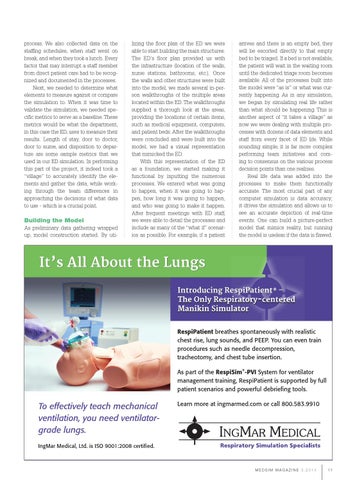process. We also collected data on the staffing schedules, when staff went on break, and when they took a lunch. Every factor that may interrupt a staff member from direct patient care had to be recognized and documented in the processes. Next, we needed to determine what elements to measure against or compare the simulation to. When it was time to validate the simulation, we needed specific metrics to serve as a baseline. These metrics would be what the department, in this case the ED, uses to measure their results. Length of stay, door to doctor, door to nurse, and disposition to departure are some sample metrics that we used in our ED simulation. In performing this part of the project, it indeed took a “village” to accurately identify the elements and gather the data, while working through the team differences in approaching the decisions of what data to use - which is a crucial point.
Building the Model As preliminary data gathering wrapped up, model construction started. By uti-
lizing the floor plan of the ED we were able to start building the main structures. The ED’s floor plan provided us with the infrastructure (location of the walls, nurse stations, bathrooms, etc.). Once the walls and other structures were built into the model, we made several in-person walkthroughs of the multiple areas located within the ED. The walkthroughs supplied a thorough look at the areas, providing the locations of certain items, such as medical equipment, computers, and patient beds. After the walkthroughs were concluded and were built into the model, we had a visual representation that mimicked the ED. With this representation of the ED as a foundation, we started making it functional by inputting the numerous processes. We entered what was going to happen, when it was going to happen, how long it was going to happen, and who was going to make it happen. After frequent meetings with ED staff, we were able to detail the processes and include as many of the “what if” scenarios as possible. For example, if a patient
arrives and there is an empty bed, they will be escorted directly to that empty bed to be triaged. If a bed is not available, the patient will wait in the waiting room until the dedicated triage room becomes available. All of the processes built into the model were “as is” or what was currently happening. As in any simulation, we began by simulating real life rather than what should be happening. This is another aspect of “it takes a village” as now we were dealing with multiple processes with dozens of data elements and staff from every facet of ED life. While sounding simple, it is far more complex performing team initiatives and coming to consensus on the various process decision points than one realizes. Real life data was added into the processes to make them functionally accurate. The most crucial part of any computer simulation is data accuracy; it drives the simulation and allows us to see an accurate depiction of real-time events. One can build a picture-perfect model that mimics reality, but running the model is useless if the data is flawed.
M E D SI M M AGA Z INE 3 . 2 0 1 4
11
